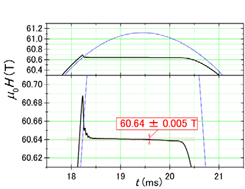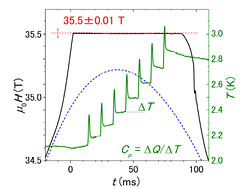Generation of Flat-Top Pulsed Magnetic Fields at ISSP
Kindo Group
Pulsed magnetic fields are commonly used where extremely strong magnetic fields are required. However, pulsed magnetic fields only persist for a short period of time which makes a scientific research difficult to conduct. The most commonly used pulsed field is driven by a capacitor bank and its field duration is typically from 1 to 100 milliseconds. Because of the extremely short timescale, most of experiments are difficult to perform, and only selected measurement techniques (such as magnetization and electronic resistivity) have been applied in pulsed magnetic fields. To solve this problem, some facilities in foreign countries start to utilize a flywheel generator and produces a “long” pulsed magnetic field that has ~1 second pulsed field duration. In 2008, International MegaGauss Science Laboratory at ISSP also installed the 51.3 MW DC flywheel generator and successfully produced long pulsed magnetic fields. The use of flywheel generator also enables us to generate a flat-top pulsed magnetic field (FTPMF) which has a constant field region around the maximum field. Since the FTPMF is the most demanding field profile for performing a precise experiment, we are now trying to generate highly stabilized FTPMFs with a homemade feedback controller. In this report, we would shortly describe our recent achievement of generating a FTPMF and its application to a scientific research.

Fig. 1. Flattop pulsed field profile generated by 60 T user-coil and 1.2 T mini-coil. The user-coil and mini-coil were driven by the conventional capacitance banks and the lead batteries, respectively. The magnetic field generated by mini-coil is regulated by a homemade feedback controller and makes the pulsed field profile flat on the top of pulsed fields. The black (blue) curve is obtained with (without) the feedback control.

Fig. 2. Flattop pulsed field profile obtained with 36 T long pulsed magnet and 1.1 T mini-coil, which were driven by the DC flywheel generator and the lead batteries, respectively. The black curve indicates a field profile of a stabilized FTPMF. The field profile generated only with 36 T long pulsed magnet (no feedback control) is shown by a blue dashed curve. The temperature (green curve) and heat power (not shown) were recorded for the specific heat measurement.
Our homemade feedback controller consists of a FPGA (field programmable gate array) devise and a mini-coil circuit and is used in conjunction with a commonly used pulsed magnet [1]. The mini-coil is inserted into a pulsed magnet and modifies the original pulsed field profile to obtain a FTPMF. In Fig. 1 and 2, we show the generated field profiles of FTPMFs (60.64 ± 0.005 T for 2 ms and 35.5 ± 0.01 T for 90 ms) which are obtained with the mid-pulsed magnet (36 ms, 60 T) and the long-pulsed magnet (1.2 s, 36 T), respectively. In both cases, an extremely high field stability (±0.005~0.01 T) were obtained with feedback control of magnetic fields (see black curves). Since there is currently no alternative way to produce a FTPMF with high stability of the magnetic field, these FTPMFs can be used for improving the resolution of data with signal averaging or for performing a slow measurement (such as NMR and specific heat) at unprecedented high magnetic fields. The FTPMF shown in Fig. 2 is already utilized to perform a collaboration research and some specific heat data have been obtained. As shown as the green curve in Fig. 2, the temperature of the sample was recorded as a function of time. During the stabilized FTPMF, we applied heat pulses (ΔQ) to the sample and observed the resultant temperature jumps (ΔT). From each temperature jump, we successfully estimated the specific heat (Cp = ΔQ/ΔT) and obtained several specific heat data points from a single pulse of magnetic fields.
We are planning to extend the time duration of FTPMF by a factor of 2 to 3 in 2016. Adding to the specific heat measurement, the generation of a highly stabilized FTPMF may open the way to perform a precise measurement that has never been possible in pulsed magnetic fields.
References
- [1] Y. Kohama and K. Kindo, Rev. Sci. Instrum. 86, 104701 (2015).
